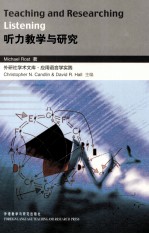
- 作 者:(美)Michael Rost著
- 出 版 社:北京:外语教学与研究出版社
- 出版年份:2012
- ISBN:7560085296
- 标注页数:309 页
- PDF页数:329 页
请阅读订购服务说明与试读!
订购服务说明
1、本站所有的书默认都是PDF格式,该格式图书只能阅读和打印,不能再次编辑。
2、除分上下册或者多册的情况下,一般PDF页数一定要大于标注页数才建议下单购买。【本资源329 ≥309页】
图书下载及付费说明
1、所有的电子图书为PDF格式,支持电脑、手机、平板等各类电子设备阅读;可以任意拷贝文件到不同的阅读设备里进行阅读。
2、电子图书在提交订单后一般半小时内处理完成,最晚48小时内处理完成。(非工作日购买会延迟)
3、所有的电子图书都是原书直接扫描方式制作而成。
Introduction:Interests,beliefs and metaphors 1
Section Ⅰ Defining listening 5
1 Neurological processes 7
1.1 Hearing 7
1.2 Consciousness 11
1.3 Attention 12
2 Linguistic processing 17
2.1 Perceiving speech 17
2.2 Recoguising words 20
2.3 Employing phonotactic rules 24
2.4 Applying grammatical rules 26
2.5 Managing spoken language 30
2.6 Utilising prosodic features 32
2.7 Integrating non-verbal cues 35
3 Pragmatic processing 39
3.1 Inferring speaker intention 39
3.2 Invoking social frames 46
3.3 Listener response 50
3.4 Listener collaboration 54
4 Psycholinguistic processing 59
4.1 Comprehension 59
4.2 Knowledge activation 62
4.3 Inference 64
4.4 Memory 69
4.5 Learning 72
5 Natural language processing 75
5.1 Speech recognition 76
5.2 Semantic analysis 78
6 Listening development and language acquisition 81
6.1 First language(L1)development of perception 81
6.2 L1 contextualised input 86
6.3 L1 cognitive restructuring 88
6.4 L2 acquisition:the role of listening 90
6.5 L2 listening acquisition:comprehensible input 92
6.6 L2 listening development:phonological and lexical processing 94
6.7 L2 listening development:syntactic processing 96
6.8 L2 listening success or failure:context for learning 98
Section Ⅱ Teaching listening 101
7 Approaches to teaching listening 103
7.1 Principles of instructional design 104
7.2 Influences from second language learning research 107
8 Methods 115
8.1 The historical search for the best method 115
8.2 Anti-methods and post methods 117
8.3 Skills taxonomies 119
9 Input 122
9.1 Relevance 122
9.2 Authenticity 123
9.3 Genres 126
9.4 Difficulty 128
9.5 Simplification 130
9.6 Teacher talk 134
10 Instructional design 137
10.1 Intensive listening 138
10.2 Selective listening 139
10.3 Interactive listening 143
10.4 Grammar processing 146
10.5 Multimedia 150
10.6 Strategy training 154
10.7 Listening-awareness training 157
10.8 Listening projects 162
10.9 Academic listening 162
10.10 Content-based listening 164
10.11 Self-access listening 165
11 Methods for assessing listening 169
11.1 Types of tests 169
11.2 Specifications 170
11.3 Forms of tests 172
11.4 Factors that influence test performance 174
11.5 Deconstructing tests 175
11.6 Helping students prepare for tests 178
11.7 Oral interview tests 178
11.8 Listening proficiency scales 182
11.9 Testing example:an achievement test 183
Section Ⅲ Researching listening 199
12 Approaches to researching listening 201
12.1 Purposes for research 201
12.2 Posing questions 202
13 Listening research projects 205
13.1 Listening in daily life 206
13.2 Listening and social roles 209
13.3 Pragmatic analysis 211
13.4 Cross-cultural pragmatics 214
13.5 Developing pragmatic competence 216
13.6 Speech processing 219
13.7 Comprehension and memory 223
13.8 Listening in interaction 225
13.9 Benchmarking effective listening 227
13.10 Causes of misunderstanding 230
13.11 Listening to lectures 233
13.12 Strategy training 236
13.13 Materials design and evaluation 239
13.14 Listening journals 240
13.15 Designing a self-access listening centre 242
13.16 Sample action research report 245
Section Ⅳ Exploring listening 253
14 Resources and references 255
14.1 Sources of listening material 255
14.2 Teaching resources 260
14.3 Guides for researching listening 269
14.4 Natural language processing research 271
Glossary 272
References 285
Index 302
